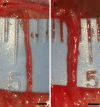Modification of blood vessel diameter following perivascular application of botulinum toxin-A
- PMID: 19194764
- PMCID: PMC2724620
- DOI: 10.1007/s11552-009-9169-8
Modification of blood vessel diameter following perivascular application of botulinum toxin-A
Abstract
The purpose of this study was to demonstrate that perivascularly applied botulinum toxin-A (BTX) increases the diameter of treated blood vessels in a rat femoral vessel exposure model. Six adult Sprague-Dawley rats were used and bilateral femoral artery and vein exposures were performed. Five units of BTX were applied to the experimental side and an equal volume of sterile saline was applied to the control side. Digital images of the vessels were obtained at the following time points: pretreatment, immediately posttreatment, and postoperative days (POD) 1, 14, and 28. Vessel diameters were equivalent at baseline and immediately following application of BTX and saline. The BTX artery was significantly larger than the control artery on POD 1 and 14. The BTX treated artery was significantly larger than all other vessels on POD 14 (p < 0.05) as well as all prior time points (p < 0.01). Direct perivascular application of BTX increases the diameter of rat femoral vessels as early as POD 1. The affect is most robust on POD 14 where the artery was significantly larger than all other vessels at all time points. It is likely that the increased diameter of blood vessels results in an increased blood flow across the area of dilation. Such an increase in flow may serve to improve end-organ perfusion in microvascular procedures.
Figures




References
-
- {'text': '', 'ref_index': 1, 'ids': [{'type': 'DOI', 'value': '10.1158/1078-0432.CCR-05-1222', 'is_inner': False, 'url': 'https://doi.org/10.1158/1078-0432.ccr-05-1222'}, {'type': 'PubMed', 'value': '16489084', 'is_inner': True, 'url': 'https://pubmed.ncbi.nlm.nih.gov/16489084/'}]}
- Ansiaux R, Baudelet C, Cron GO, et al. Botulinum toxin potentiates cancer radiotherapy and chemotherapy. Clin Cancer Res. 2006;12(4):1276–83. - PubMed
-
- {'text': '', 'ref_index': 1, 'ids': [{'type': 'PubMed', 'value': '5321530', 'is_inner': True, 'url': 'https://pubmed.ncbi.nlm.nih.gov/5321530/'}]}
- Attinger E. The physics of pulsatile blood flow with particular reference to small vessels. Invest Ophthalmol. 1965;4(6):973–87. - PubMed
-
- {'text': '', 'ref_index': 1, 'ids': [{'type': 'DOI', 'value': '10.1097/01.PRS.0000144795.76040.D3', 'is_inner': False, 'url': 'https://doi.org/10.1097/01.prs.0000144795.76040.d3'}, {'type': 'PubMed', 'value': '15507786', 'is_inner': True, 'url': 'https://pubmed.ncbi.nlm.nih.gov/15507786/'}]}
- Carruthers J, Fagien S, Matarasso SL, Group BC. Consensus recommendations on the use of botulinum toxin type A in facial aesthetics. Plast Reconstr Surg. 2004;114(6 Suppl):1S–22S. - PubMed
-
- {'text': '', 'ref_index': 1, 'ids': [{'type': 'DOI', 'value': '10.1097/01.prs.0000197214.57838.9b', 'is_inner': False, 'url': 'https://doi.org/10.1097/01.prs.0000197214.57838.9b'}, {'type': 'PubMed', 'value': '16462327', 'is_inner': True, 'url': 'https://pubmed.ncbi.nlm.nih.gov/16462327/'}]}
- Celik E, Tercan M, Uzunismail A, Saglam A. Versatility of botulinum toxin: a use in stabilization of pedicled muscle flaps. Plast Reconstr Surg. 2006;117(2):462–7. - PubMed
-
- {'text': '', 'ref_index': 1, 'ids': [{'type': 'DOI', 'value': '10.1080/09638280701568296', 'is_inner': False, 'url': 'https://doi.org/10.1080/09638280701568296'}, {'type': 'PubMed', 'value': '18033601', 'is_inner': True, 'url': 'https://pubmed.ncbi.nlm.nih.gov/18033601/'}]}
- Dressler K, Benecke R. Pharmacology of therapeutic botulinum toxin preparations. Disabil Rehabil. 2007;29(23):1761–8. - PubMed
LinkOut - more resources
Full Text Sources
Other Literature Sources
Medical

